Adding an order number
Overview
- You will modify the workflow and add an order number to each coffee order.
- To do this, you will add a state that increments a counter value in a DynamoDB table and uses this for the current execution.
- You will test the new workflow and see the input and output payloads.
After this section, you will have a workflow that assigns an order number to the order.
Updating an atomic counter in a DynamoDB table
In this section, you use a DynamoDB integration in Step Functions to increment an atomic counter and use the value as the order number.
Step-by-step instructions
-
Go to the Step Functions console. From the AWS Management Console, select Services then select Step Functions under Application Integration. Make sure your region is correct.
-
From the left-hand menu, select State machine and choose OrderProcessorWorkflow from the list. Choose Edit.
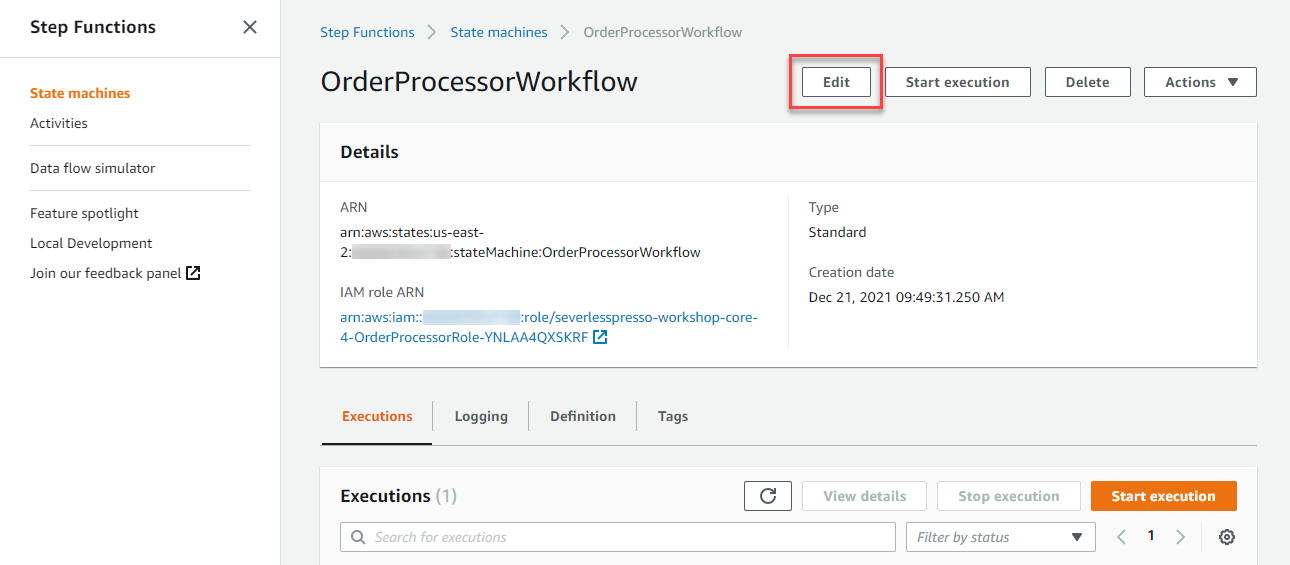
-
On the next page, choose Workflow Studio to open the workflow in the designer.
-
With the Actions tab selected on the left, enter
updateitemin the search bar. Drag the Amazon DynamoDB UpdateItem action from the list to between the Is capacity available? and Pass states in the designer.
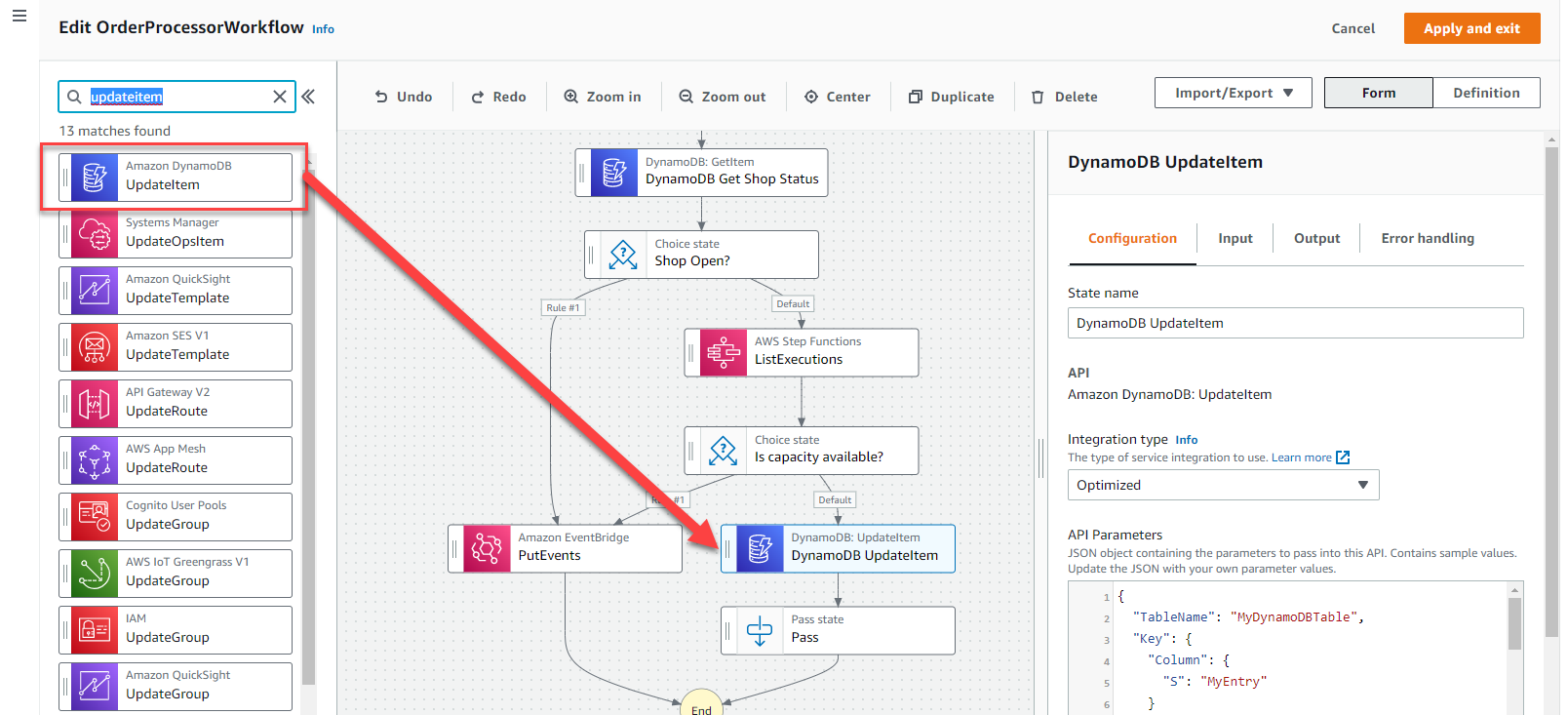
- With the state selected, the attribute panel on the right shows the configuration for this state. In the Configuration tab:
- For State name, enter
Generate Order Number. - For API Parameters, paste the following DynamoDB query:
{
"TableName": "serverlesspresso-counting-table",
"Key": {
"PK": {
"S": "orderID"
}
},
"UpdateExpression": "set IDvalue = IDvalue + :val",
"ExpressionAttributeValues": {
":val": {
"N": "1"
}
},
"ReturnValues": "UPDATED_NEW"
}
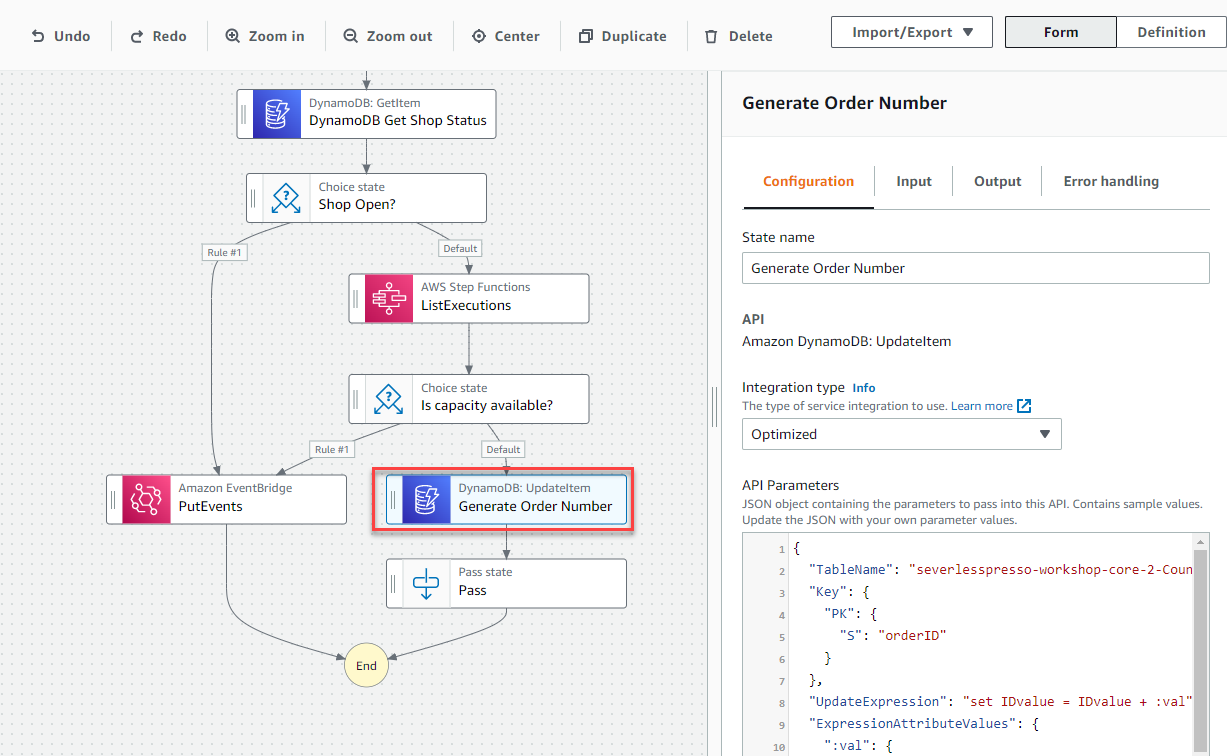
- Choose the Output tab. Here, you will modify the state’s output to include the result from the DynamoDB query:
- Check the box Transform result with ResultSelector.
- In the value textbox, enter:
{
"orderNumber.$": "$.Attributes.IDvalue.N"
}
- Check the box Add original input to output using ResultPath.
- Ensure the dropdown is set to Combine original input with result.
- In the value textbox, enter
$.Order.Payload.
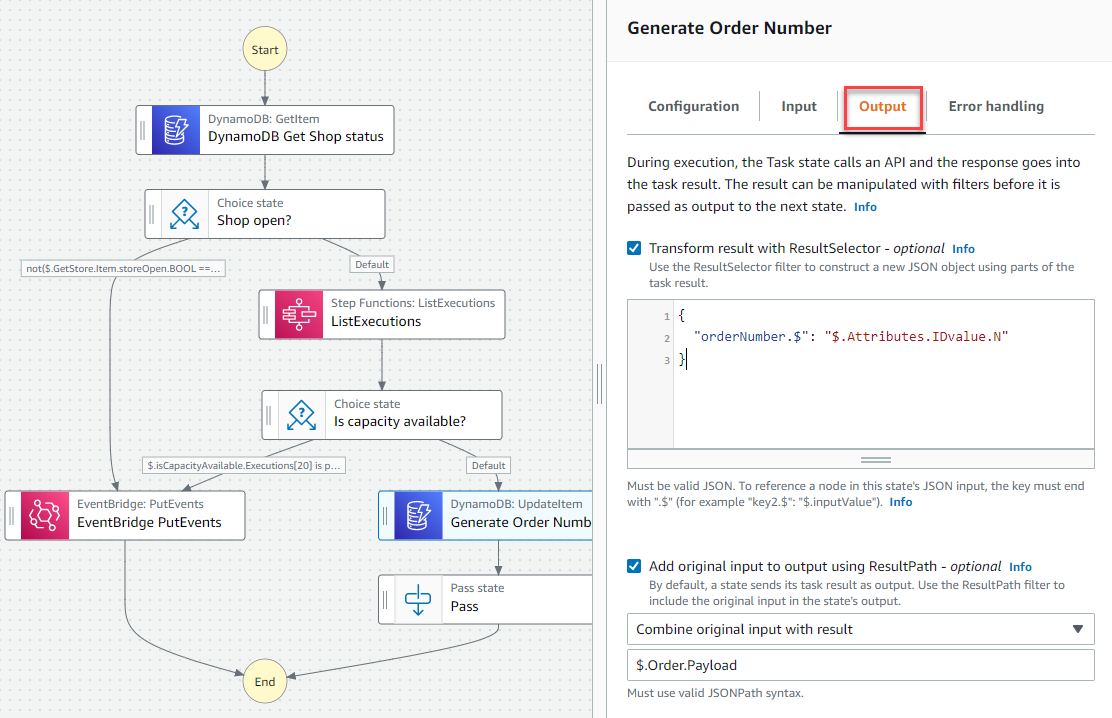
- Check the Amazon States Language (ASL) definition by choosing the Definition toggle button above the designer. The ASL appears as:
{
"Comment": "A description of my state machine",
"StartAt": "DynamoDB Get Shop status",
"States": {
"DynamoDB Get Shop status": {
"Type": "Task",
"Resource": "arn:aws:states:::dynamodb:getItem",
"Parameters": {
"TableName": "serverlesspresso-config-table",
"Key": {
"PK": {
"S": "config"
}
}
},
"ResultPath": "$.GetStore",
"Next": "Shop Open?"
},
"Shop Open?": {
"Type": "Choice",
"Choices": [
{
"Not": {
"Variable": "$.GetStore.Item.storeOpen.BOOL",
"BooleanEquals": true
},
"Next": "EventBridge PutEvents"
}
],
"Default": "ListExecutions"
},
"ListExecutions": {
"Type": "Task",
"Next": "Is capacity available?",
"Parameters": {
"StateMachineArn": "YOUR_STATE_MACHINE_ARN",
"MaxResults": 100,
"StatusFilter": "RUNNING"
},
"Resource": "arn:aws:states:::aws-sdk:sfn:listExecutions",
"ResultPath": "$.isCapacityAvailable"
},
"Is capacity available?": {
"Type": "Choice",
"Choices": [
{
"Variable": "$.isCapacityAvailable[20]",
"IsPresent": true,
"Next": "EventBridge PutEvents"
}
],
"Default": "Generate Order Number"
},
"Generate Order Number": {
"Type": "Task",
"Resource": "arn:aws:states:::dynamodb:updateItem",
"Parameters": {
"TableName": "serverlesspresso-counting-table",
"Key": {
"PK": {
"S": "orderID"
}
},
"UpdateExpression": "set IDvalue = IDvalue + :val",
"ExpressionAttributeValues": {
":val": {
"N": "1"
}
},
"ReturnValues": "UPDATED_NEW"
},
"Next": "Pass",
"ResultPath": "$.Order.Payload",
"ResultSelector": {
"orderNumber.$": "$.Attributes.IDvalue.N"
}
},
"EventBridge PutEvents": {
"Type": "Task",
"Resource": "arn:aws:states:::events:putEvents.waitForTaskToken",
"Parameters": {
"Entries": [
{
"Detail": {
"Message": "Hello from Step Functions!",
"TaskToken.$": "$$.Task.Token"
},
"DetailType": "MyDetailType",
"EventBusName": "MyEventBusName",
"Source": "MySource"
}
]
},
"End": true
},
"Pass": {
"Type": "Pass",
"End": true
}
}
}
-
Choose Apply and exit. In the Edit page, choose Save.
-
In the Edit OrderProcessorWorkflow page, choose Save.
-
Choose Save anyway in the IAM popup.
Testing the Step Functions workflow
In this section, you will test the changes to the workflow.
Step-by-step instructions
-
From the previous section, on the page showing the new workflow, choose Start execution. In the Start execution pop-up, choose Start execution.
-
After the execution is finished, the console shows a results page. The left side shows the flow of execution with the green states showing the actual path. Choose the Generate Order Number state to show the details on the right side.
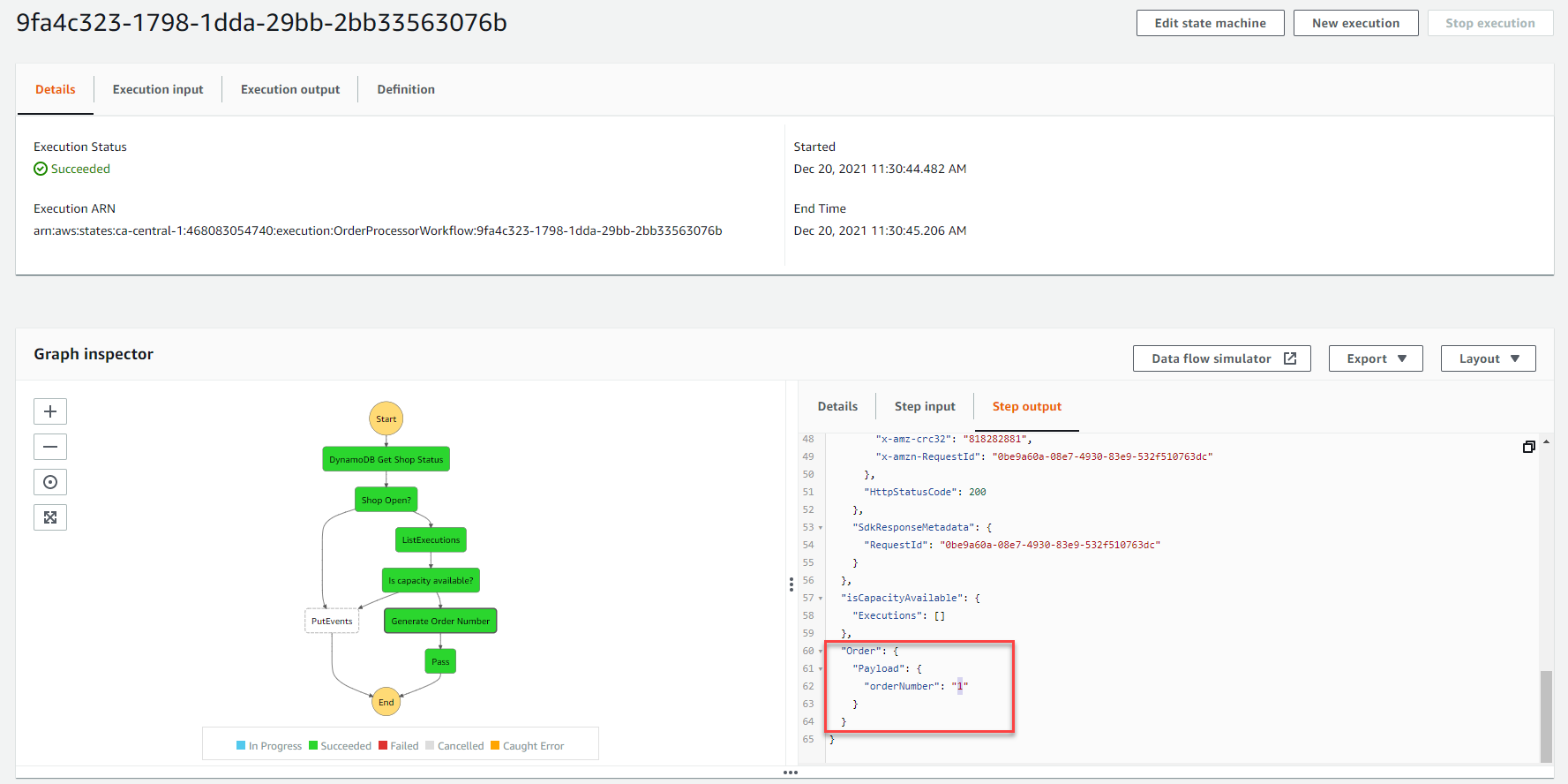
-
Choose the Step output on the right side to see the output path for the choice state. The JSON output shows an Order attribute with a Payload containing an orderNumber of 1.
-
Choose Start execution again and repeat steps 2 and 3. The orderNumber is now 2. Each time you run start another execution, the order number is incremented.
Recap
- In this section, you add a state transition that assigns a unique, incrementing order number to the execution.
- This increments a value in the counting DynamoDB table and appends the result in the output payload.
- You tested this new feature in the console to see how the order ID increments with each execution.
Next steps
Next, you’ll add a wait condition to the workflow, to wait for the customer to submit their order.